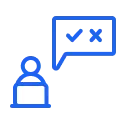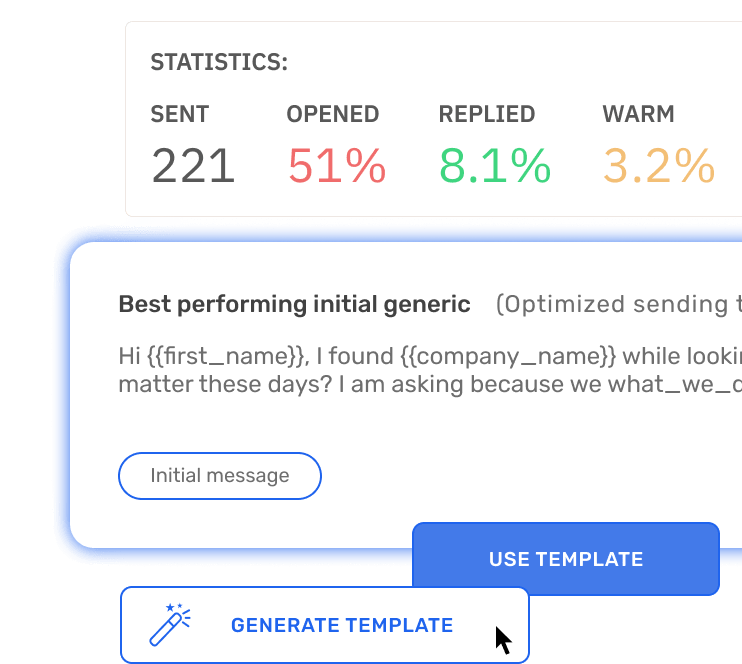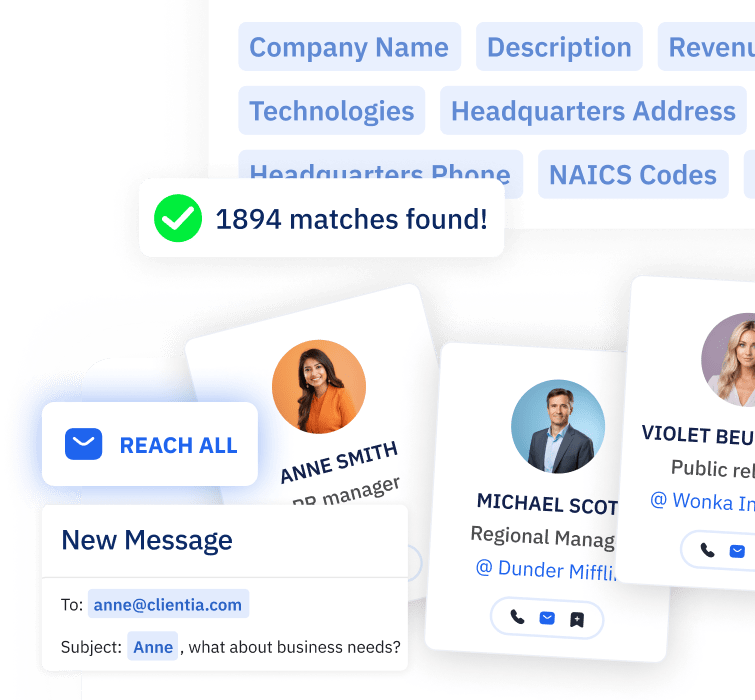Getting better results from outbound sales is what we have been about since we started as a company.
We are always looking for new ways to optimize our campaigns and help our customers achieve awesome results with their sales or email marketing campaigns, so it should come as no surprise that we have been looking for better information about when is the best time to send email campaigns.
Of course, it isn’t just us.
Salespeople and email marketers have been trying to nail the time to send an email campaign with limited success for a long time.
While well intentioned, these efforts haven’t been able to get specific enough to have a great effect on the email marketing results. It is simply because no one has ever tried to connect reliable data on email delivery with demographic data about the recipients of the email.
After all, different groups have different habits and demographics. Would you expect a startup founder to be receptive to emails at the same time as the CEO of a Fortune 500 company?
Are you wondering whether you are sending emails at a perfect time? Continue reading to find out.
Learning what is the best time to send an email to your target group or email subscribers can ensure the highest open rates and click through rates.

Filip Kubiński
Outbound Expert at Growbots
When is the best time to send an email
There are countless articles on the internet trying to pinpoint the best days to send emails that can get you the highest open rate. We gathered the most important insights as well as our own observations for you so if you want to increase the performance of your email marketing campaigns.
Based on over 1,000,000 cold email campaigns sent using our email outreach platform as well as our research, the best time to send emails is after 2 PM on Tuesdays, Wednesdays, and Thursdays.
Why does it matter to find out the best time for email campaigns?
Finding out what is the principal time to send your outreach campaigns is crucial if you want to be successful with your sales endeavors and increase your conversion rates.
If you want to keep your email open rates high, your email must be delivered at the right time and day so that it doesn’t get lost among all the other emails the recipient receives.
After all, there is nothing worse than spending lots of time on curating the perfect messages with engaging subject lines for your sales or email marketing campaigns, and then sending them at the wrong time so they remain unread forever.
On that note, while knowing the best times to send your sales or promotional emails, there is something else you should put some consideration into: your subject lines.
Why, you might ask?
Every sent email means a subject line to go with it. Considering that in 2022 alone there were 333.2 billion emails sent and received, that’s 333.2 billion email subject lines trying to catch the recipients’ attention.
What can you do to make the subject line of your marketing email effective? Over 1,000,000 sales and email marketing cold messages were sent through Growbots.
During a simple A/B test and analysis of which ones got the best open rates and the highest click through rates, this simple formula came up the most: (Name of recipient) x (Name of Sender). It makes sense because it is short and personalized.
There is also a bad way to structure your subject line while doing email marketing that can negatively impact your click through rates. The examples of a bad subject line include:
- riddles (e.g. Do you know what your product team is doing wrong?)
- a “quick question” subject lines
- email headlines that sound like a spammy marketing newsletter.
But hey – this is an article where you initially wanted to learn about the best time to send emails in order to get the highest open rate.
We covered the topic of subject lines in detail in one of our previous articles so make sure to check it out if you want to elevate the way you attract the attention of your target audience even more.
Sending emails at the right time also means higher email open rates.
Open rate indicates the percentage of opened emails for a specific campaign (cold emails, marketing emails, promotional emails etc.).
Of course, to get your message across, you want to aim at the highest open rates in your campaigns.
So what else should you keep in mind to keep your open rates high?
Besides choosing the correct time to send emails and catching subject lines, you should also make sure that your deliverability is high so that the emails you send aren’t flagged as spam.
Deliverability is crucial if you want your cold or marketing emails to perform well with high open rates and reply rates. For this reason, you should always care about your email reputation and follow best practices for sending limits.

Chris Traczyk
Deliverability Expert at Growbots
The role of data in finding the best time to send emails
As Growbots, we are in a unique position.
On one hand, we provide our customers with a dataset of highly targeted leads.
This data includes information like the job title of your prospect along with the size, age, location, and vertical of the company targeted.
On the other hand, half of our product is a cold email automation tool which our customers use to automatically send out their cold or marketing emails to their target audience at times they specify.
Using AI, we are then able to identify which of the responses they get are successful.
There have been over 1,000,000 cold email campaigns sent using our platform which makes for a ton of data covering the best times to contact different segments as well as unique insights into what impacts your cold email metrics like open rates.
Of course, all of this data is difficult to make actionable on its own.
For that reason, our data science team built a machine learning model to determine the time to send emails to a particular segment which would guarantee the best results.
This is how our Email Time Optimizer tool came to life.
Using this tool, it is really easy to input the segment you want to target and see what time you are most likely to get a response.
Why does this make a difference knowing the best time to schedule an email campaign?
Let’s look at the example of a CEO of a small technology company in San Francisco. If you send your campaign to this segment on Tuesday at 7:15 AM, you will only get a 3.7 percent of positive response rate on average.
That makes sense as your prospect will probably be cleaning out all of their emails from the night before and yours will get lost in the shuffle.
But if you just wait with sending emails for a few hours until 11:45 AM on Tuesday, you’ll get a 6.8% positive response rate on average.

A message can be twice as likely to convert purely depending on when you send it
Knowing the best days to send emails will not only impact your open rate or make your marketing emails seen so you’re in constant contact with your recipients.
Thanks to the right timing, you can double your conversion which has serious knock-on effects and can effectively double the revenue you generate from your outbound pipeline.
Of course, you should frequently use your campaign monitor or dashboard to track the performance of your actions and adjust the email schedule accordingly.
Sometimes, a certain day of the week will work for one group but it might not for a different one.
Doubling your conversion rate has serious knock-on effects and can effectively double the reveue you generate from outbound sales.

Filip Kubiński
Outbound Expert at Growbots
So see for yourself when the best time to send emails is.
To find the perfect time to schedule your next campaign to your email list, simply put your prospect’s demographic information into the tool. The information you get could be the key to getting more positive responses from your emails, no matter if they are cold or marketing emails.
To show you the impact your prospect’s demographics can have on the optimal time to send them an email campaign, we have looked at a couple of examples to see how optimizing sending time can be helpful.
From that we came up with 5 reasons doing this will help you convert more emails.
5 reasons why finding the best time to send emails will help your emails convert
While the one example I gave above can illustrate our point, it is still an anecdote.
A more thorough study would provide better information about how optimizing email send times would be useful.
To do this, we did two different studies to see how changing a variable can affect the best time to convert an email.
Reach More with Less Effort
Connect with Potential Clients at scale
- AI message generator
- E-mail verification
- Multichannel sequences
- A/B testing
Our Method
For both of these studies we used these baseline criteria:
A small (<200 employees) company founded after 2010
To make sure the results weren’t localized to a specific area, industry or profession, we looked at the popular searches on our platform.
From this we developed a list of 6 time zones (US West Coast, US East Coast, UK, Continental Europe, India, and Japan/Korea), three verticals (technology, corporate services, transportation), and job titles (CEO, VP Marketing, Head of HR) which we got conversion data for.
For each of these combinations, we first looked at what happened if you took that baseline company and changed the age of the company.
We then took the baseline and saw what happened when you changed the size of the company.
What we wanted to see is how much the information in our email sending time optimizer could help you convert.
In other words, how much of a difference picking the right time would make over picking randomly (the average for the week).
From these studies, we found these 6 insights:
1. You can almost double your response rate, just by optimizing your send time
Let’s say you are starting out with cold email and are just getting by with a 2.5% positive response rate.
On average we found that when we looked at companies of all different ages there was an average 2.8% bump from sending your messages at the right time.
And when we looked at companies of all sizes, we saw an average bump of 2.4%.
What that means is that you could bump your 2.5% response rate to around 5%, just by optimizing send time.
And of course, that is the average. Certain buy personas see a much bigger swing.
Take the 5.8% bump you see here:
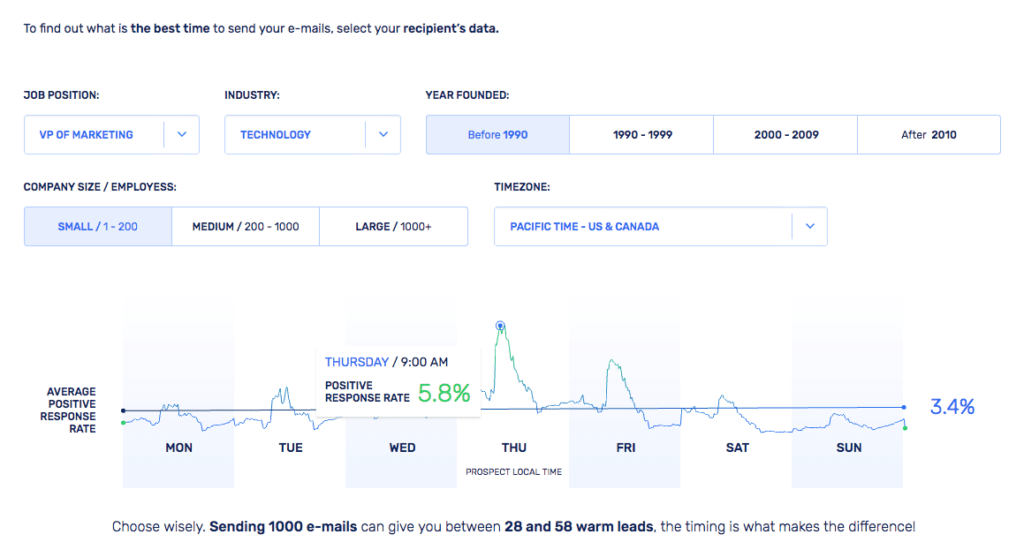
By sending your message at 9 AM on a Thursday, you boost your conversion rate by 70% over the average. This has a big impact on your outbound pipeline.
Since conversion comes at the beginning of your pipeline, doubling it can effectively double the revenues you get.
2. The size of your prospect’s company has a big impact on conversion
The way your prospects treat your message is often down to the way their company works and smaller companies work differently than larger companies.
This can be in how they innovate or the experience of what it’s like to work there.
So it will come as no surprise that the size of a company can affect the way people work, meaning that it can also determine when they respond to emails.
Let’s take our baseline example:
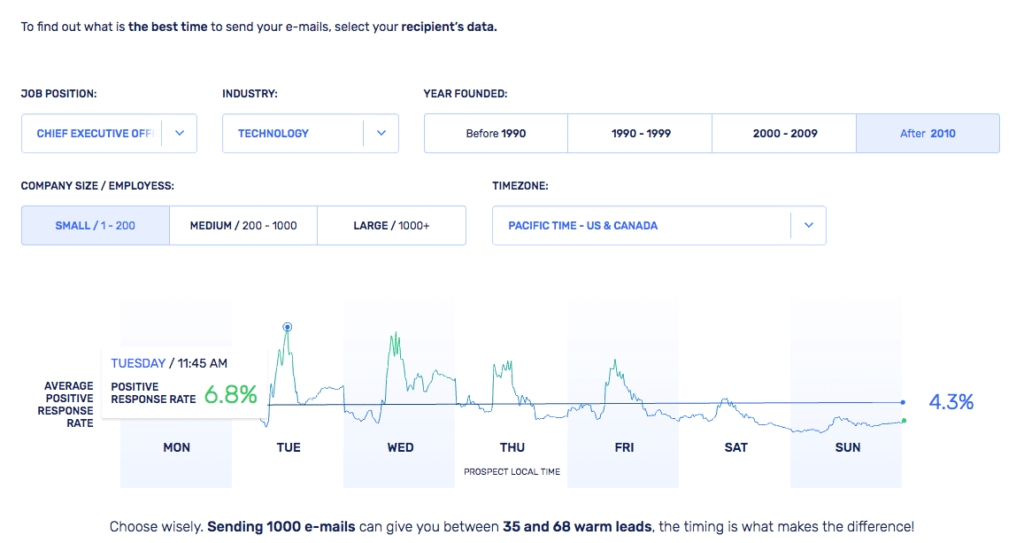
And make it a medium sized company:
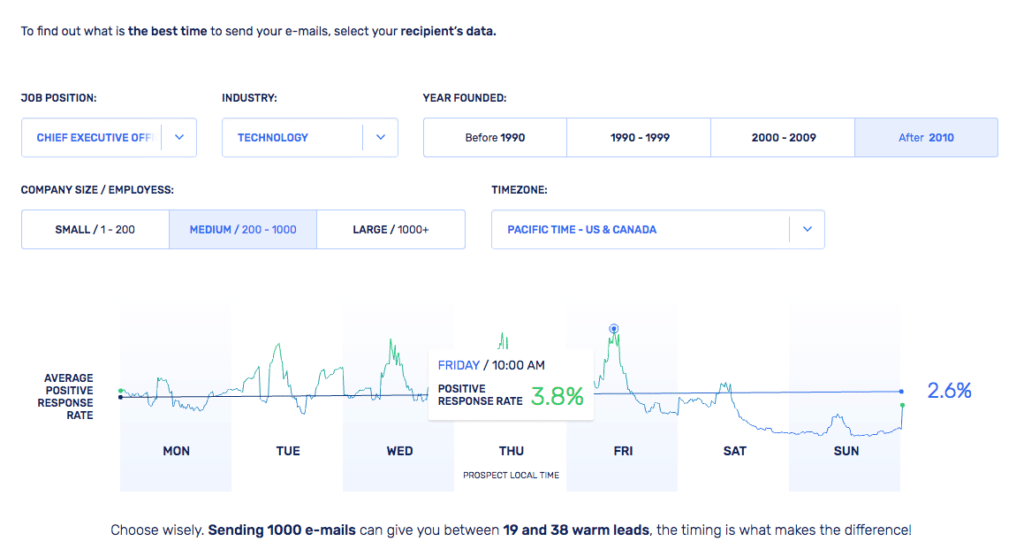
Two things jump out.
The first is that you generally see lower conversion from a larger company but the more important difference is that your message has the best chance of converting three days later.
In fact, if you optimized your campaign for a small company and then used that same sending time for a medium company, you would only have a 3.1% chance of converting only 0.4% better than average.
On the flip side, if you optimize for the medium sized company, you do a bit better but lose 1% off your conversion rate.
3. Almost nobody has their best day on Monday or Tuesday but you should still send emails on those days
As you can see from this chart of the study we did based on company age, none of the prospects we studied would be best contacted on Monday.
Tuesday was only slightly better with only slightly over 3% of the days.
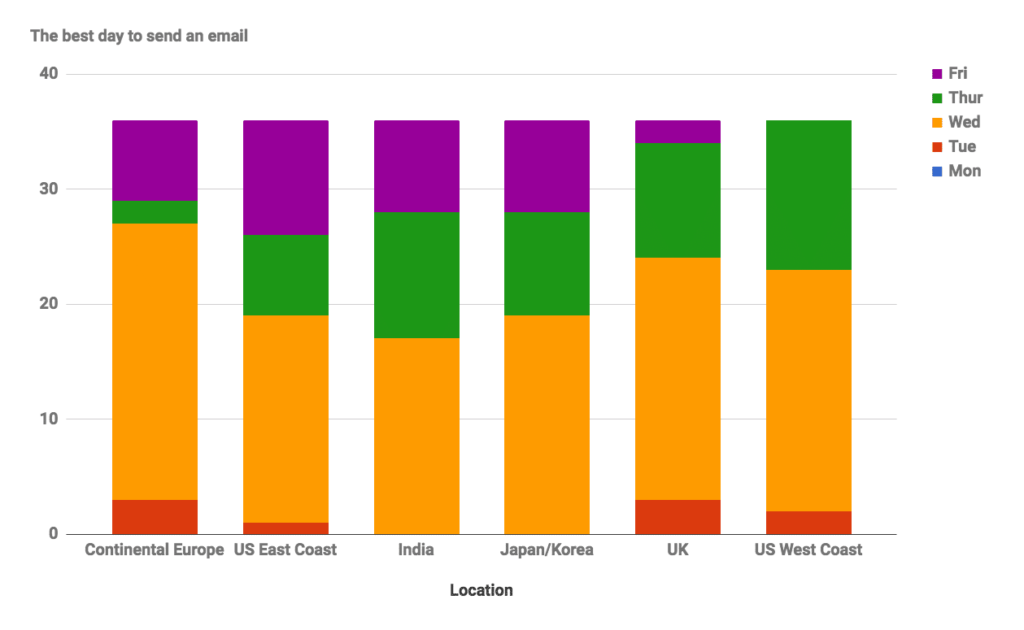
So does that mean you should never send an email out on Monday or Tuesday? Of course not. When you are presented with this prospect you certainly should:
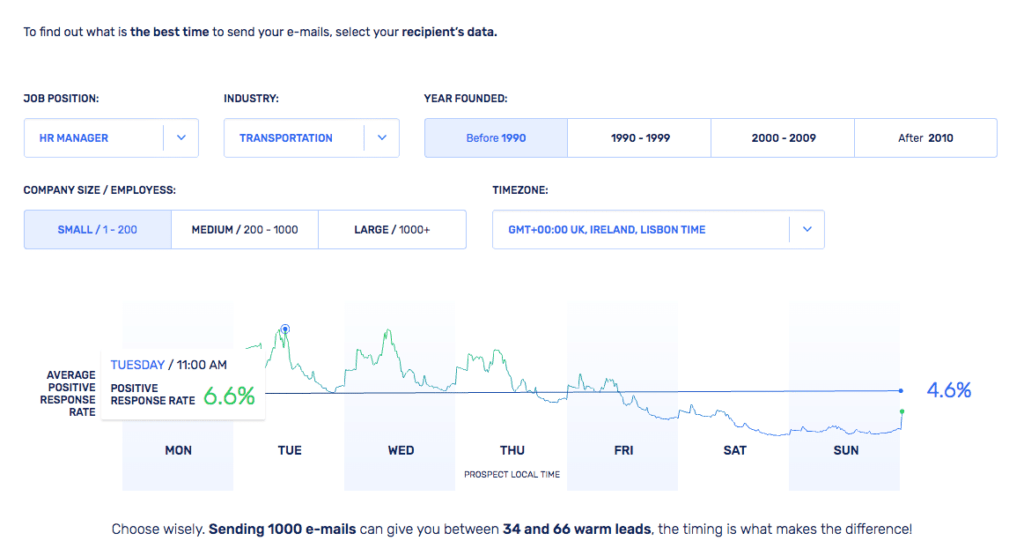
The point is that there is no such thing as the best day or the worst day to send out cold emails. There is only the day which is perfect for your prospect.
4. Small changes to the size of a company can mean a 9-hour difference between the time of day you should send your email campaign
For this first prospect, it is best to contact them at 9:45 am but if you just make the company medium sized you get this:

For this first prospect, it is best to contact them at 9:45 am but if you just make the company medium sized you get this:
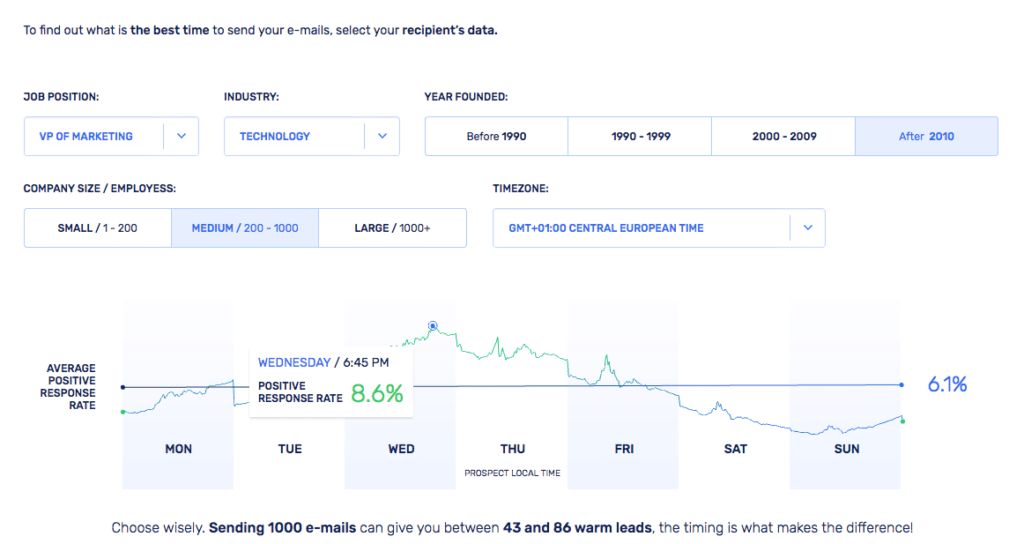
The best time to email this second prospect is 9 hours later in the day. The point here is that there are no criteria too small to optimize since one little change can make a big difference.
5. The benefit you see from optimizing the time you send your email changes depending on your target
It is important to be realistic about the benefits you can get for optimization.
They tend to change based on targeting so we found that we got the biggest benefit targeting the Japanese market (3.2% on average) when studying the age of the prospect’s company while it was continental Europe that got the biggest bump (2.6% on average) when we studied size.
You can see that optimizing for different criteria will get you a different average bump to your conversion.

The point is that you will get different results depending on who you are targeting.
That said, it’s always important to optimize the time of your emails as there is almost always a benefit.
So, what is the best time to send an email campaign?
The most optimal time to send your email campaign depends heavily on your particular target audience and the time zone that audience is located in.
However, in general there are specific times you should consider while planning your sales or email marketing campaigns.
For instance, sending your cold email in the early morning might be a good idea.
Why?
As recipients check their inboxes while commuting to work or the first thing when they start their day, the message will appear at the top and as a result, the chances of it being read are higher.
In general, prospects are most likely to be receptive to your message during regular business hours – they are usually checking their inboxes then. For this reason work hours make a good time to schedule your outbound campaigns..
At Growbots, we recommend our clients to schedule their emails after 2 p.m. as usually this is when most people have finished their lunch breaks.
In light of that, you might consider sending your emails during the evening on different days as part of your recipients might check their emails before going to sleep.
Seek, pick, and reach
Connect with your potential customers
- 180m+ contacts
- Advanced filtering
- Multichannel sequences
- CRM integrations
What is the worst time to send emails?
As we stated above, the time to send your emails depends on your target group.
There is no one particular worst day to send your marketing email.
There are, however, universal times when you should avoid sending emails if you want to see the results.
For instance, you should refrain from sending important emails during lunch time as people usually don’t check their business inboxes then.
Another time period which is not ideal when scheduling your sending are the holidays.
Naturally, the holidays are the time when people take days off and are usually not reachable.
However, the worst time to send your emails is shortly before you or your sales reps start vacation.
Just imagine – you send an email campaign which turns out to be successful and you start getting a lot of warm replies but there is nobody to answer them.
What is the best day to send an email campaign?
Whether you’re one of email marketers or sales reps, you should know how to choose the best day to send your emails.
The internet is full of articles attempting to answer the question of which day of the week is the best day for email outreach.
According to various studies and our own observations, the three best days to send out emails are Tuesdays, Wednesdays, and Thursdays.
What about the rest of the week? Should you refrain from sending emails then?
Well, on Mondays, people have a lot of things to run through to catch up after the weekend.
Similarly, Fridays are when people are already thinking about the weekend and focusing on closing things they had planned for the week. It’s a good practice to avoid sending first messages then, but a soft follow-up may work just great.
During the weekend the open rates of your emails might be low as it is uncommon for people to open their inboxes on Saturdays and Sundays since they are off work or relaxing.
To sum up, weekdays show significantly higher open rates as compared to the weekends, making them a good time to send emails.
FAQ
Still having doubts? Here are some additional questions that we often get:
What are the differences between email marketing and email outreach?
The difference between cold email outreach and email marketing is that cold email outreach is targeted at people that aren’t familiar with you or your business, while email marketing messages go to people who have opted to receive your emails and that you want to nurture.
In other words, email marketing activities target already acquired audiences, whereas cold email outreach messages are for brand-new prospects you find on your own.
Can I optimize my sending time using Google Analytics?
Google Analytics is a powerful platform which collects data from your websites or apps to generate reports that provide insight into your business. It can definitely take a lot of the guesswork out of when to send your email outreach.
How?
For instance, in the Google Analytics dashboard you can find your traffic breakdown in hours-in-the-day and days-of-the-week across.
This data gives you an insight into when your target audience is visiting your website and can work as a guideline in terms of when you should try to send your cold emails.
However, it is important to remember that this data lacks the additional insights when it comes to your target audience – their location, industry, position, company size etc.
For this reason, our Email Time Optimizer is still the best tool to discover and test the optimal sending time for your potential clients.
What to do now
We would be the first to admit that these findings are outliers of a couple rather limited studies of email sending’s timing so how can they provide value for you?
The point of these is not to explain trends that you should take as gospel when timing your emails.
Instead, we want to emphasize that every situation can be different. This used to pose a problem in the past.
After all, the best data out there wasn’t segmented, severely reducing its actionability.
Now, you can use our tool to find the time to send an email for the best results based on your target persona. It is an incredibly easy and free way to get more positive responses to your emails.

Filip Kubiński
Outbound Sales Expert at Growbots

